Multi-Dimensional Driving Mechanisms and Scenario Simulation of Production-Living-Ecological Space Evolution in Urban Agglomerations of China: Evidence from the Guanzhong Plain
Abstract
1. Introduction
2. Literature Review
2.1. Theoretical Foundations of Production-Living-Ecological Space
2.1.1. Evolution and Conceptualization of PLE Space Theory
2.1.2. International Perspectives and Comparative Frameworks
2.2. Driving Mechanisms of Spatial Evolution
2.2.1. Proximate and Underlying Drivers
2.2.2. Scale Dependencies and Spatial Heterogeneity
2.3. Spatial Simulation Methods and Scenario Analysis
2.3.1. Evolution of Land Use Simulation Models
2.3.2. Recent Advances in PLUS Model and Applications
2.3.3. Scenario Development and Policy Applications
2.4. Research Gaps and Study Contributions
3. Materials and Methods
3.1. Study Area and Data Sources
3.1.1. Geographic and Socioeconomic Context
3.1.2. Data Collection and Preprocessing
3.2. Analytical Framework
3.2.1. Production-Living-Ecological Space Classification System
3.2.2. Spatial Pattern Evolution Analysis
- (1)
- Spatial Gravity Center Migration Model
- (2)
- Land Use Transfer Matrix
- (3)
- Land Use Intensity Spectrum Analysis
3.2.3. Driving Factor Identification
3.3. Markov Chain-PLUS Coupled Model and Scenario Design
3.3.1. Markov Chain Model
3.3.2. PLUS Model Principles and Implementation
3.3.3. Multi-Scenario Parameter Settings
- (1)
- Natural Evolution Scenario (NES): Maintains historical land use transition trends without additional policy interventions. Transition probabilities use 2001–2021 averages, with default neighborhood weights and conversion costs.
- (2)
- Urban Development Priority Scenario (UDPS): Emphasizes economic construction and urban expansion. Increases conversion probability from cropland and grassland to built-up land by 30%, reduces built-up land conversion cost by 20%, and sets built-up land neighborhood weight to 1.2.
- (3)
- Food Security Priority Scenario (FSPS): Strictly protects basic farmland to ensure food production capacity. Reduces conversion probability from cropland to other land uses by 60%, establishes basic farmland protection zones as conversion-restricted areas, and sets cropland neighborhood weight to 1.1.
- (4)
- Ecological Protection Priority Scenario (EPPS): Strengthens ecological space protection and restoration. Reduces conversion probability from forest and grassland to other land uses by 50%, sets ecological land neighborhood weight to 1.3, and establishes conversion restrictions in ecological redline areas.
4. Results
4.1. Spatiotemporal Evolution of PLE Space Patterns
4.1.1. Spatial Distribution and Structural Changes
4.1.2. Gravity Center Migration Trajectories
4.2. Land Use Transfer Dynamics and Intensity Analysis
4.2.1. Land Use Transfer Patterns
4.2.2. Land Use Dynamic Degrees
4.2.3. Land Use Intensity Spectrum Evolution
4.3. Driving Mechanisms of PLE Space Evolution
4.3.1. Driving Factors of Cropland Production Space Expansion
4.3.2. Driving Factors of Forest Ecological Space Expansion
4.3.3. Driving Factors of Shrubland Ecological Space Expansion
4.3.4. Driving Factors of Grassland Ecological Space Expansion
4.3.5. Driving Factors of Water Ecological Space Expansion
4.3.6. Driving Factors of Barren Land Ecological Space Expansion
4.3.7. Driving Factors of Built-Up Living Space Expansion
4.4. Multi-Scenario Evolution Simulation Based on Markov Chain-PLUS Coupled Model
4.4.1. Model Validation and Accuracy Assessment
4.4.2. Markov Chain Projection Results
4.4.3. Multi-Scenario Design and Parameter Configuration
- (1)
- Natural Evolution Scenario (NES)
- (2)
- Urban Development Priority Scenario (UDPS)
- (3)
- Food Security Priority Scenario (FSPS)
- (4)
- Ecological Protection Priority Scenario (EPPS)
4.4.4. Scenario Simulation Results and Analysis
5. Discussion
5.1. Complex System Characteristics and Theoretical Contributions of PLE Space Evolution
5.2. Decision Support Value and Policy Implications of Multi-Scenario Analysis
5.3. Research Limitations and Future Directions
6. Conclusions
- (1)
- PLE space evolution in the GPUA exhibits distinct stage characteristics with significant spatial restructuring. Living space expanded by 73.89% while production and ecological spaces contracted by 7.47% and 8.94%, respectively, over the 20-year period. The evolution process displayed four distinct phases—rapid expansion (2001–2006), structural adjustment (2006–2011), quality improvement (2011–2016), and green transformation (2016–2021)—each corresponding to national policy shifts but manifesting with regional time lags. The divergent migration trajectories of PLE space gravity centers (production space shifting 23.4 km southwest, ecological space moving 18.9 km northwest, living space remaining stable) reveal the asymmetric nature of regional development and the persistence of established urban hierarchies despite rapid transformation.
- (2)
- Driving mechanisms of PLE space evolution demonstrate complex nonlinear relationships and strong scale dependencies. Environmental factors (precipitation, temperature, elevation) establish the fundamental template for spatial patterns, contributing 45–55% of explanatory power. However, their influence varies significantly across space types and geographic regions—economic factors dominate in plains (>40% contribution), environmental factors prevail in mountains (>60%), and social factors peak in peri-urban zones (35–45%). The identification of threshold effects (e.g., elevation’s constraint on population-driven urban expansion above 1000 m) and interaction effects among multiple drivers challenges linear conceptualizations of land use change and highlights the need for sophisticated analytical approaches to capture system complexity.
- (3)
- Multi-scenario simulations reveal inevitable trade-offs but also optimization possibilities through strategic spatial planning. No single development pathway can simultaneously maximize all PLE space functions—urban development scenarios achieve 55.34% built-up land expansion but sacrifice agricultural and ecological integrity, while conservation scenarios preserve ecosystem services but constrain economic growth potential. However, the ecological protection scenario demonstrates that careful spatial allocation can achieve 92% of baseline food production capacity while maintaining the highest ecological connectivity (0.63) and carbon storage (1287 Mt C), suggesting that integrated planning approaches can partially reconcile competing objectives. These findings emphasize the necessity of explicit priority-setting and differentiated strategies tailored to regional contexts rather than uniform policy applications.
- (4)
- The integrated Markov chain-PLUS modeling framework advances land use simulation methodology and provides robust decision support for sustainable development. The coupled approach achieved exceptional validation accuracy (Kappa = 0.91), demonstrating its reliability for policy-relevant projections. By combining quantity projection with spatial allocation, incorporating machine learning for driver identification, and enabling multi-scenario exploration, the framework addresses key limitations of existing models while maintaining computational efficiency. Beyond methodological contributions, this study provides actionable insights for the GPUA’s sustainable development: core metropolitan areas should prioritize compact development, agricultural zones require consolidated protection with modernization, and ecological areas need integrated conservation with community welfare. These differentiated strategies, implemented through adaptive governance mechanisms, can guide the region toward a more sustainable spatial configuration that balances economic prosperity, food security, and ecological integrity in the face of continued urbanization pressure.
Author Contributions
Funding
Data Availability Statement
Conflicts of Interest
References
- Seto, K.C.; Güneralp, B.; Hutyra, L.R. Global Forecasts of Urban Expansion to 2030 and Direct Impacts on Biodiversity and Carbon Pools. Proc. Natl. Acad. Sci. USA 2012, 109, 16083–16088. [Google Scholar] [CrossRef]
- United Nations Department of Economic and Social Affairs. World Urbanization Prospects: The 2018 Revision; United Nations: New York, NY, USA, 2019; ISBN 978-92-1-004314-4. [Google Scholar]
- Bibi, S.; Duclos, J.-Y. L’effet des prélèvements fiscaux et des transferts aux particuliers sur la pauvreté au Québec et au Canada. Can. Public Policy 2011, 37, 1–24. [Google Scholar] [CrossRef]
- Li, Y.; Zhao, J.; Zhang, S.; Zhang, G.; Zhou, L. Qualitative-Quantitative Identification and Functional Zoning Analysis of Production-Living-Ecological Space: A Case Study of Urban Agglomeration in Central Yunnan, China. Environ. Monit. Assess. 2023, 195, 1163. [Google Scholar] [CrossRef] [PubMed]
- Wang, Q.; Wang, H.; Zeng, H.; Chang, R.; Bai, X. Understanding Relationships between Landscape Multifunctionality and Land-Use Change across Spatiotemporal Characteristics: Implications for Supporting Landscape Management Decisions. J. Clean. Prod. 2022, 377, 134474. [Google Scholar] [CrossRef]
- Lee, E.; Kim, G. Analysis of Domestic and International Green Infrastructure Research Trends from the ESG Perspective in South Korea. Int. J. Environ. Res. Public Health 2022, 19, 7099. [Google Scholar] [CrossRef] [PubMed]
- Padró, R.; La Rota-Aguilera, M.J.; Giocoli, A.; Cirera, J.; Coll, F.; Pons, M.; Pino, J.; Pili, S.; Serrano, T.; Villalba, G.; et al. Assessing the Sustainability of Contrasting Land Use Scenarios through the Socioecological Integrated Analysis (SIA) of the Metropolitan Green Infrastructure in Barcelona. Landsc. Urban Plan. 2020, 203, 103905. [Google Scholar] [CrossRef]
- Fernández-Martínez, M.; Janssens, I.A.; Obersteiner, M.; Manning, P.; Andrade, F.M.; Rodríguez-Penedo, E.; Peñuelas, J. Temporal Complexity of Terrestrial Ecosystem Functioning and Its Drivers. Nat. Commun. 2025, 16, 7725. [Google Scholar] [CrossRef]
- Su, N.; Tang, R.; Zhang, Y.; Ni, J.; Huang, Y.; Liu, C.; Xiao, Y.; Zhu, B.; Zhao, Y. Using Machine Learning to Identify Risk Factors for Pancreatic Cancer: A Retrospective Cohort Study of Real-World Data. Front. Pharmacol. 2024, 15, 1510220. [Google Scholar] [CrossRef]
- Antonelli, G.; Puddu, G.; Cipollini, C.; Sabatini, G.; Conticelli, M.; Simeone, M.C. A Vanishing Imprint? Modeling the Present and Future Distribution of the Enigmatic Quercus Crenata Lam., a Mediterranean Sporadic Tree Species. Ecol. Evol. 2025, 15, e71482. [Google Scholar] [CrossRef]
- Ye, H.; Song, Y.; Xue, D. Multi-Scenario Simulation of Land Use and Habitat Quality in the Guanzhong Plain Urban Agglomeration, China. Int. J. Environ. Res. Public Health 2022, 19, 8703. [Google Scholar] [CrossRef]
- Gentine, P.; Alemohammad, S.H. Reconstructed Solar-Induced Fluorescence: A Machine Learning Vegetation Product Based on MODIS Surface Reflectance to Reproduce GOME-2 Solar-Induced Fluorescence. Geophys. Res. Lett. 2018, 45, 3136–3146. [Google Scholar] [CrossRef]
- Ye, Y.; Pandey, A.; Bawden, C.; Sumsuzzman, D.M.; Rajput, R.; Shoukat, A.; Singer, B.H.; Moghadas, S.M.; Galvani, A.P. Integrating Artificial Intelligence with Mechanistic Epidemiological Modeling: A Scoping Review of Opportunities and Challenges. Nat. Commun. 2025, 16, 581. [Google Scholar] [CrossRef]
- Han, L.; Qin, T.; Sun, Z.; Ren, H.; Zhao, N.; An, X.; Wang, Z. Influence of Urbanization on the Spatial Distribution of Associations Between Air Pollution and Mortality in Beijing, China. GeoHealth 2023, 7, e2022GH000749. [Google Scholar] [CrossRef]
- Iglesias-Carrasco, M.; Medina, I.; Ord, T.J. Global Effects of Forest Modification on Herpetofauna Communities. Conserv. Biol. 2023, 37, e13998. [Google Scholar] [CrossRef] [PubMed]
- Elum, Z.A.; Mopipi, K.; Henri-Ukoha, A. Oil Exploitation and Its Socioeconomic Effects on the Niger Delta Region of Nigeria. Environ. Sci. Pollut. Res. 2016, 23, 12880–12889. [Google Scholar] [CrossRef]
- Liu, X.; Wei, M.; Zeng, J. Simulating Urban Growth Scenarios Based on Ecological Security Pattern: A Case Study in Quanzhou, China. Int. J. Environ. Res. Public Health 2020, 17, 7282. [Google Scholar] [CrossRef] [PubMed]
- Xu, C.; Xie, D.; Gu, C.; Zhao, P.; Wang, X.; Wang, Y. Sustainable Development Pathways for Energies in Yangtze River Delta Urban Agglomeration. Sci. Rep. 2023, 13, 18135. [Google Scholar] [CrossRef]
- Severo, E.A.; De Guimarães, J.C.F.; Dellarmelin, M.L. Impact of the COVID-19 Pandemic on Environmental Awareness, Sustainable Consumption and Social Responsibility: Evidence from Generations in Brazil and Portugal. J. Clean. Prod. 2021, 286, 124947. [Google Scholar] [CrossRef]
- López, D.; Sáez, P.L.; Cavieres, L.A.; Beveridge, F.C.; Saavedra-Mella, F.; Bravo, L.A. Morpho-Physiological Traits and Dehydration Tolerance of High-Altitude Andean Wetland Vegetation in the Chilean Atacama Region. Plant-Environ. Interact. 2025, 6, e70038. [Google Scholar] [CrossRef]
- Yang, G.; Liu, Y.; Wen, S.; Chen, W.; Zhu, X.; Wang, Y. DTI-MHAPR: Optimized Drug-Target Interaction Prediction via PCA-Enhanced Features and Heterogeneous Graph Attention Networks. BMC Bioinform. 2025, 26, 11. [Google Scholar] [CrossRef]
- Marrec, R.; Abdel Moniem, H.E.; Iravani, M.; Hricko, B.; Kariyeva, J.; Wagner, H.H. Conceptual Framework and Uncertainty Analysis for Large-Scale, Species-Agnostic Modelling of Landscape Connectivity across Alberta, Canada. Sci. Rep. 2020, 10, 6798. [Google Scholar] [CrossRef]
- Zhang, D.; Wang, J.; Wang, Y.; Xu, L.; Zheng, L.; Zhang, B.; Bi, Y.; Yang, H. Is There a Spatial Relationship between Urban Landscape Pattern and Habitat Quality? Implication for Landscape Planning of the Yellow River Basin. Int. J. Environ. Res. Public Health 2022, 19, 11974. [Google Scholar] [CrossRef] [PubMed]
- Sriver, R.L.; Lempert, R.J.; Wikman-Svahn, P.; Keller, K. Characterizing Uncertain Sea-Level Rise Projections to Support Investment Decisions. PLoS ONE 2018, 13, e0190641. [Google Scholar] [CrossRef]
- Simkin, S.; Chamberland-Rowe, C.; Damba, C.; Sava, N.; Lim, T.; Bourgeault, I.L. Implementing Leading Practices in Regional-Level Primary Care Workforce Planning: Lessons Learned in Toronto. Healthc. Manag. Forum 2023, 36, 15–20. [Google Scholar] [CrossRef] [PubMed]
- Thiault, L.; Mora, C.; Cinner, J.E.; Cheung, W.W.L.; Graham, N.A.J.; Januchowski-Hartley, F.A.; Mouillot, D.; Sumaila, U.R.; Claudet, J. Escaping the Perfect Storm of Simultaneous Climate Change Impacts on Agriculture and Marine Fisheries. Sci. Adv. 2019, 5, eaaw9976. [Google Scholar] [CrossRef] [PubMed]
- Yao, L.; Halike, A.; Yao, K.; Wei, Q.; Tang, H.; Tuheti, B.; Luo, J.; Duan, Y. Dynamic Simulation of Landscape Ecological Security and Analysis of Coupling Coordination Degree: A Case Study of Bole. PLoS ONE 2024, 19, e0297860. [Google Scholar] [CrossRef]
- Li, Y.; Beeton, R.J.S.; Sigler, T.; Halog, A. Enhancing the Adaptive Capacity for Urban Sustainability: A Bottom-up Approach to Understanding the Urban Social System in China. J. Environ. Manag. 2019, 235, 51–61. [Google Scholar] [CrossRef]
- Li, Y.; Xie, H. Spatial–Temporal Variation and Correlation Analysis of Ecosystem Service Values and Ecological Risks in Winter City Shenyang, China. Sci. Rep. 2024, 14, 18182. [Google Scholar] [CrossRef]
- Zhang, H.; Yang, Q.; Zhang, Z.; Lu, D.; Zhang, H. Spatiotemporal Changes of Ecosystem Service Value Determined by National Land Space Pattern Change: A Case Study of Fengdu County in The Three Gorges Reservoir Area, China. Int. J. Environ. Res. Public Health 2021, 18, 5007. [Google Scholar] [CrossRef]
- Lemiere, L.; Jaeger, M.; Gosme, M.; Subsol, G. Combinatorial Maps, a New Framework to Model Agroforestry Systems. Plant Phenomics 2023, 5, 0120. [Google Scholar] [CrossRef]
- Brandt, J. Multifunctional Landscapes—Perspectives for the Future. J. Environ. Sci. 2003, 15, 187–192. [Google Scholar]
- Sun, H.; Cheng, L.; Li, Z.; Wang, Q.; Teng, J. A Land-Use Benefit Evaluation System with Case Study Verification. PLoS ONE 2022, 17, e0271557. [Google Scholar] [CrossRef]
- Hansen, R.; Pauleit, S. From Multifunctionality to Multiple Ecosystem Services? A Conceptual Framework for Multifunctionality in Green Infrastructure Planning for Urban Areas. AMBIO 2014, 43, 516–529. [Google Scholar] [CrossRef]
- Luo, K.; Wang, H.; Ma, C.; Wu, C.; Zheng, X.; Xie, L. Carbon Sinks and Carbon Emissions Balance of Land Use Transition in Xinjiang, China: Differences and Compensation. Sci. Rep. 2022, 12, 22456. [Google Scholar] [CrossRef]
- Xu, H.; Zhang, F.; Li, W.; Shi, J.; Johnson, B.A.; Tan, M.L. Spatial-Temporal Pattern of Change in Production-Living-Ecological Space of Nanchong City from 2000 to 2020 and Underlying Factors. Environ. Monit. Assess. 2023, 196, 94. [Google Scholar] [CrossRef] [PubMed]
- Tabatabaei Hosseini, S.A.; Kazemzadeh, R.; Foster, B.J.; Arpali, E.; Süsal, C. New Tools for Data Harmonization and Their Potential Applications in Organ Transplantation. Transplantation 2024, 108, 2306–2317. [Google Scholar] [CrossRef] [PubMed]
- Welch, H.; Brodie, S.; Jacox, M.G.; Bograd, S.J.; Hazen, E.L. Decision-support Tools for Dynamic Management. Conserv. Biol. 2020, 34, 589–599. [Google Scholar] [CrossRef] [PubMed]
- McMahon, S.; Matzke, M.; Tuni, C. Food Limitation but Not Enhanced Rates of Ejaculate Production Imposes Reproductive and Survival Costs to Male Crickets. Cells 2021, 10, 1498. [Google Scholar] [CrossRef]
- Johnson, A.H.; Harrison, T.C. Advanced Practice Registered Nurse Transition to Practice in the Long-Term Care Setting: An Ethnography. Glob. Qual. Nurs. Res. 2022, 9, 23333936221108701. [Google Scholar] [CrossRef]
- Stephanou, C.; Omirou, M.; Philippot, L.; Zissimos, A.M.; Christoforou, I.C.; Trajanoski, S.; Oulas, A.; Ioannides, I.M. Land Use in Urban Areas Impacts the Composition of Soil Bacterial Communities Involved in Nitrogen Cycling. A Case Study from Lefkosia (Nicosia) Cyprus. Sci. Rep. 2021, 11, 8198. [Google Scholar] [CrossRef]
- Khadka, D.; Babel, M.S.; Tingsanchali, T.; Penny, J.; Djordjevic, S.; Abatan, A.A.; Giardino, A. Evaluating the Impacts of Climate Change and Land-Use Change on Future Droughts in Northeast Thailand. Sci. Rep. 2024, 14, 9746. [Google Scholar] [CrossRef]
- Li, Y.; Ma, Y.; Liu, J.; Yang, J. Analysis of the Spatial and Temporal Evolution of Urban Resilience in Four Southern Regions of Xinjiang. Int. J. Environ. Res. Public Health 2023, 20, 5106. [Google Scholar] [CrossRef] [PubMed]
- Simon, F.; Gironás, J.; Rivera, J.; Vega, A.; Arce, G.; Molinos-Senante, M.; Jorquera, H.; Flamant, G.; Bustamante, W.; Greene, M.; et al. Toward Sustainability and Resilience in Chilean Cities: Lessons and Recommendations for Air, Water, and Soil Issues. Heliyon 2023, 9, e18191. [Google Scholar] [CrossRef] [PubMed]
- Schebella, M.F.; Weber, D.; Schultz, L.; Weinstein, P. The Nature of Reality: Human Stress Recovery during Exposure to Biodiverse, Multisensory Virtual Environments. Int. J. Environ. Res. Public Health 2020, 17, 56. [Google Scholar] [CrossRef] [PubMed]
- Erb, K.H. How a Socio-Ecological Metabolism Approach Can Help to Advance Our Understanding of Changes in Land-Use Intensity. Ecol. Econ. 2012, 76, 8–14. [Google Scholar] [CrossRef]
- Dabinett, G. Spatial Justice and the Translation of European Strategic Planning Ideas in the Urban Sub-Region of South Yorkshire. Urban Stud. 2010, 47, 2389–2408. [Google Scholar] [CrossRef]
- Liu, L.; Tian, Y. Does the Compact City Paradigm Help Reduce Poverty? Evidence from China. Int. J. Environ. Res. Public Health 2022, 19, 6184. [Google Scholar] [CrossRef]
- Xu, N.; Chen, W.; Pan, S.; Liang, J.; Bian, J. Evolution Characteristics and Formation Mechanism of Production-Living-Ecological Space in China: Perspective of Main Function Zones. Int. J. Environ. Res. Public Health 2022, 19, 9910. [Google Scholar] [CrossRef]
- Obersteiner, M.; Walsh, B.; Frank, S.; Havlík, P.; Cantele, M.; Liu, J.; Palazzo, A.; Herrero, M.; Lu, Y.; Mosnier, A.; et al. Assessing the Land Resource–Food Price Nexus of the Sustainable Development Goals. Sci. Adv. 2016, 2, e1501499. [Google Scholar] [CrossRef]
- Chi, G.; Wang, D. Population Projection Accuracy: The Impacts of Sociodemographics, Accessibility, Land Use, and Neighbour Characteristics. Popul. Space Place 2018, 24, e2129. [Google Scholar] [CrossRef]
- Ngouhouo-Poufoun, J.; Chaupain-Guillot, S.; Ndiaye, Y.; Sonwa, D.J.; Njabo, K.Y.; Delacote, P. Cocoa, Livelihoods, and Deforestation within the Tridom Landscape in the Congo Basin: A Spatial Analysis. PLoS ONE 2024, 19, e0302598. [Google Scholar] [CrossRef]
- Luan, C.; Liu, R.; Zhang, Q.; Sun, J.; Liu, J. Multi-objective land use optimization based on integrated NSGA–II–PLUS model: Comprehensive consideration of economic development and ecosystem services value enhancement. J. Clean. Prod. 2024, 434, 140306. [Google Scholar] [CrossRef]
- Jakovac, C.C.; Dutrieux, L.P.; Siti, L.; Peña-Claros, M.; Bongers, F. Spatial and Temporal Dynamics of Shifting Cultivation in the Middle-Amazonas River: Expansion and Intensification. PLoS ONE 2017, 12, e0181092. [Google Scholar] [CrossRef] [PubMed]
- Kariuki, R.W.; Munishi, L.K.; Courtney-Mustaphi, C.J.; Capitani, C.; Shoemaker, A.; Lane, P.J.; Marchant, R. Integrating Stakeholders’ Perspectives and Spatial Modelling to Develop Scenarios of Future Land Use and Land Cover Change in Northern Tanzania. PLoS ONE 2021, 16, e0245516. [Google Scholar] [CrossRef] [PubMed]
- Dai, E.; Wu, S.; Shi, W.; Cheung, C.; Shaker, A. Modeling Change-Pattern-Value Dynamics on Land Use: An Integrated GIS and Artificial Neural Networks Approach. Environ. Manag. 2005, 36, 576–591. [Google Scholar] [CrossRef][Green Version]
- Guo, L.; Liu, Y.; Jiang, Z.; Yuan, X.; Jing, Q. Impact of Land Prices on Corporate Carbon Emission Intensity. Sci. Rep. 2025, 15, 3632. [Google Scholar] [CrossRef]
- Sellers, S.; Bilsborrow, R.; Salinas, V.; Mena, C. Population and Development in the Amazon: A Longitudinal Study of Migrant Settlers in the Northern Ecuadorian Amazon. Acta Amaz. 2017, 47, 321–330. [Google Scholar] [CrossRef]
- Shi, Y.; Zhu, Q.; Xu, L.; Lu, Z.; Wu, Y.; Wang, X.; Fei, Y.; Deng, J. Independent or Influential? Spatial-Temporal Features of Coordination Level between Urbanization Quality and Urbanization Scale in China and Its Driving Mechanism. Int. J. Environ. Res. Public Health 2020, 17, 1587. [Google Scholar] [CrossRef]
- Qiu, J.; Game, E.T.; Tallis, H.; Olander, L.P.; Glew, L.; Kagan, J.S.; Kalies, E.L.; Michanowicz, D.; Phelan, J.; Polasky, S.; et al. Evidence-Based Causal Chains for Linking Health, Development, and Conservation Actions. Bioscience 2018, 68, 182–193. [Google Scholar] [CrossRef]
- Corburn, J. Urban Place and Health Equity: Critical Issues and Practices. Int. J. Environ. Res. Public Health 2017, 14, 117. [Google Scholar] [CrossRef]
- Gao, F.; Pan, J.; Gong, Z. Detection of Spatial and Temporal Variation Characteristics of Vegetation Cover in the Lower Mekong Region and the Influencing Factors. Sci. Rep. 2024, 14, 26673. [Google Scholar] [CrossRef] [PubMed]
- Garzón Delvaux, P.A.; Riesgo, L.; Gomez y Paloma, S. Are Small Farms More Performant than Larger Ones in Developing Countries? Sci. Adv. 2020, 6, eabb8235. [Google Scholar] [CrossRef] [PubMed]
- Lu, G.; Chong, Z.; Xu, E.; Na, C.; Liu, K.; Chai, L.; Xia, P.; Yang, K.; Zhu, G.; Zhao, J.; et al. Environmental, Socioeconomic, and Sociocultural Drivers of Monkeypox Transmission in the Democratic Republic of the Congo: A One Health Perspective. Infect. Dis. Poverty 2025, 14, 7. [Google Scholar] [CrossRef] [PubMed]
- Devlin, L.; Goralnik, M.; Ross, W.G.; Tart, K.T. Climate Change and Public Health in North Carolina: A Unique State Offers a Unique Perspective. Environ. Health Perspect. 2014, 122, A146–A147. [Google Scholar] [CrossRef]
- Fan, X.; Luo, W.; Yu, H.; Rong, Y.; Gu, X.; Zheng, Y.; Ou, S.; Tiando, D.S.; Zhang, Q.; Tang, G.; et al. Landscape Evolution and Simulation of Rural Settlements around Wetland Park Based on MCCA Model and Landscape Theory: A Case Study of Chaohu Peninsula, China. Int. J. Environ. Res. Public Health 2021, 18, 13285. [Google Scholar] [CrossRef]
- Schneider, J.M.; Zabel, F.; Schünemann, F.; Delzeit, R.; Mauser, W. Global Cropland Could Be Almost Halved: Assessment of Land Saving Potentials under Different Strategies and Implications for Agricultural Markets. PLoS ONE 2022, 17, e0263063. [Google Scholar] [CrossRef]
- Wang, Y. The Impacts of Improvements in the Unified Economic and Environmental Efficiency of Transportation Infrastructure on Industrial Structure Transformation and Upgrade from the Perspective of Resource Factors. PLoS ONE 2022, 17, e0278722. [Google Scholar] [CrossRef]
- Liu, S.; Su, H.; Cao, G.; Wang, S.; Guan, Q. Learning from Data: A Post Classification Method for Annual Land Cover Analysis in Urban Areas. ISPRS J. Photogramm. Remote Sens. 2019, 154, 202–215. [Google Scholar] [CrossRef]
- Liu, J.; Liu, B.; Wu, L.; Miao, H.; Liu, J.; Jiang, K.; Ding, H.; Gao, W.; Liu, T. Prediction of Land Use for the next 30 Years Using the PLUS Model’s Multi-Scenario Simulation in Guizhou Province, China. Sci. Rep. 2024, 14, 13143. [Google Scholar] [CrossRef]
- Meisel, J.D.; Sarmiento, O.L.; Olaya, C.; Lemoine, P.D.; Valdivia, J.A.; Zarama, R. Towards a Novel Model for Studying the Nutritional Stage Dynamics of the Colombian Population by Age and Socioeconomic Status. PLoS ONE 2018, 13, e0191929. [Google Scholar] [CrossRef]
- Gulliver, J.; Morris, C.; Lee, K.; Vienneau, D.; Briggs, D.; Hansell, A. Land Use Regression Modeling to Estimate Historic (1962–1991) Concentrations of Black Smoke and Sulfur Dioxide for Great Britain. Environ. Sci. Technol. 2011, 45, 3526–3532. [Google Scholar] [CrossRef] [PubMed]
- Mutale, B.; Qiang, F. Modeling Future Land Use and Land Cover under Different Scenarios Using Patch-Generating Land Use Simulation Model. A Case Study of Ndola District. Front. Environ. Sci. 2024, 12, 1362666. [Google Scholar] [CrossRef]
- Gong, J.; Li, J.; Yang, J.; Li, S.; Tang, W. Land Use and Land Cover Change in the Qinghai Lake Region of the Tibetan Plateau and Its Impact on Ecosystem Services. Int. J. Environ. Res. Public Health 2017, 14, 818. [Google Scholar] [CrossRef] [PubMed]
- Shin, B.; An, G.; Cockrell, R.C. Examining B-Cell Dynamics and Responsiveness in Different Inflammatory Milieus Using an Agent-Based Model. PLoS Comput. Biol. 2024, 20, e1011776. [Google Scholar] [CrossRef]
- Torquato, S. Toward an Ising Model of Cancer and Beyond. Phys. Biol. 2011, 8, 015017. [Google Scholar] [CrossRef]
- GB/T 21010-2017; Current Land Use Classification. General Administration of Quality Supervision, Inspection and Quarantine of the People’s Republic of China: Beijing, China; Standardization Administration of China: Beijing, China, 2017.
- Luo, Y.; Zhang, M. Environmental Modeling and Exposure Assessment of Sediment-Associated Pyrethroids in an Agricultural Watershed. PLoS ONE 2011, 6, e15794. [Google Scholar] [CrossRef]
- Getis, A.; Ord, J.K. The Analysis of Spatial Association by Use of Distance Statistics. Geogr. Anal. 1992, 24, 189–206. [Google Scholar] [CrossRef]
- Derudder, B.; Meijers, E.; Harrison, J.; Hoyler, M.; Liu, X. Polycentric Urban Regions: Conceptualization, Identification and Implications. Reg. Stud. 2022, 56, 1–6. [Google Scholar] [CrossRef]
- Zhang, H.; Li, F.; Wei, S.; Jiang, L.; Xiong, J.; Zhang, T. Spatiotemporal Evolution Characteristics and Influencing Factors of Digital Industry in China. Sci. Rep. 2024, 14, 28591. [Google Scholar] [CrossRef]
- Pontius, R.G.; Shusas, E.; McEachern, M. Detecting Important Categorical Land Changes While Accounting for Persistence. Agric. Ecosyst. Environ. 2004, 101, 251–268. [Google Scholar] [CrossRef]
- Deng, X.; Huang, J.; Rozelle, S.; Uchida, E. Growth, Population and Industrialization, and Urban Land Expansion of China. J. Urban Econ. 2008, 63, 96–115. [Google Scholar] [CrossRef]
- Georganos, S.; Grippa, T.; Vanhuysse, S.; Lennert, M.; Shimoni, M.; Wolff, E. Very High Resolution Object-Based Land Use–Land Cover Urban Classification Using Extreme Gradient Boosting. IEEE Geosci. Remote Sens. Lett. 2018, 15, 607–611. [Google Scholar] [CrossRef]
- Kohavi, R. A Study of Cross-Validation and Bootstrap for Accuracy Estimation and Model Selection. In Proceedings of the 14th International Joint Conference on Artificial Intelligence, Montreal, QC, Canada, 20–25 August 1995; Volume 2, pp. 1137–1143, ISBN 978-1-55860-363-9. [Google Scholar]
- Oshiro, T.M.; Perez, P.S.; Baranauskas, J.A. How Many Trees in a Random Forest? In Proceedings of the Machine Learning and Data Mining in Pattern Recognition, Berlin, Germany, 13–20 July 2012; Perner, P., Ed.; Springer: Berlin/Heidelberg, Germany, 2012; pp. 154–168. [Google Scholar]
- Jokar Arsanjani, J.; Helbich, M.; Kainz, W.; Darvishi Boloorani, A. Integration of Logistic Regression, Markov Chain and Cellular Automata Models to Simulate Urban Expansion. Int. J. Appl. Earth Obs. Geoinf. 2013, 21, 265–275. [Google Scholar] [CrossRef]
- Wu, D.; Zheng, L.; Wang, Y.; Gong, J.; Li, J.; Chen, Q. Urban Expansion Patterns and Their Driving Forces Analysis: A Comparison between Chengdu-Chongqing and Middle Reaches of Yangtze River Urban Agglomerations. Environ. Monit. Assess. 2023, 195, 1121. [Google Scholar] [CrossRef] [PubMed]
- Aravindakshan, S.; Krupnik, T.J.; Shahrin, S.; Tittonell, P.; Siddique, K.H.M.; Ditzler, L.; Groot, J.C.J. Socio-Cognitive Constraints and Opportunities for Sustainable Intensification in South Asia: Insights from Fuzzy Cognitive Mapping in Coastal Bangladesh. Environ. Dev. Sustain. 2021, 23, 16588–16616. [Google Scholar] [CrossRef] [PubMed]
- Duan, Y.; Tang, J.; Li, Z.; Yang, Y.; Dai, C.; Qu, Y.; Lv, H. Optimal Planning and Management of Land Use in River Source Region: A Case Study of Songhua River Basin, China. Int. J. Environ. Res. Public Health 2022, 19, 6610. [Google Scholar] [CrossRef] [PubMed]
- Alanazi, M.; Alanazi, A.; Almadhor, A.; Memon, Z.A. Multiobjective Reconfiguration of Unbalanced Distribution Networks Using Improved Transient Search Optimization Algorithm Considering Power Quality and Reliability Metrics. Sci. Rep. 2022, 12, 13686. [Google Scholar] [CrossRef]
- Fan, C.; An, R.; Li, J.; Li, K.; Deng, Y.; Li, Y. An Approach Based on the Protected Object for Dam-Break Flood Risk Management Exemplified at the Zipingpu Reservoir. Int. J. Environ. Res. Public Health 2019, 16, 3786. [Google Scholar] [CrossRef]
- Hulme, P.E. Trouble on the Horizon: Anticipating Biological Invasions through Futures Thinking. Biol. Rev. 2025, 100, 461–480. [Google Scholar] [CrossRef]
- Gerlak, A.K.; Jacobs, K.L.; McCoy, A.L.; Martin, S.; Rivera-Torres, M.; Murveit, A.M.; Leinberger, A.J.; Thomure, T. Scenario Planning: Embracing the Potential for Extreme Events in the Colorado River Basin. Clim. Change 2021, 165, 27. [Google Scholar] [CrossRef]
- Palmer, A.J.; Si, L.; Tew, M.; Hua, X.; Willis, M.S.; Asseburg, C.; McEwan, P.; Leal, J.; Gray, A.; Foos, V.; et al. Computer Modeling of Diabetes and Its Transparency: A Report on the Eighth Mount Hood Challenge. Value Health 2018, 21, 724–731. [Google Scholar] [CrossRef]
- Wang, J.; Hu, Y.; Song, R.; Wang, W. Research on the Optimal Allocation of Ecological Land from the Perspective of Human Needs—Taking Hechi City, Guangxi as an Example. Int. J. Environ. Res. Public Health 2022, 19, 12418. [Google Scholar] [CrossRef] [PubMed]
- Adams, V.M.; Pressey, R.L.; Álvarez-Romero, J.G. Using Optimal Land-Use Scenarios to Assess Trade-Offs between Conservation, Development, and Social Values. PLoS ONE 2016, 11, e0158350. [Google Scholar] [CrossRef]
- Lana, F.C.B.; Marinho, C.C.; de Paiva, B.B.M.; Valle, L.R.; do Nascimento, G.F.; da Rocha, L.C.D.; Carneiro, M.; Batista, J.d.L.; Anschau, F.; Paraiso, P.G.; et al. Unraveling Relevant Cross-Waves Pattern Drifts in Patient-Hospital Risk Factors among Hospitalized COVID-19 Patients Using Explainable Machine Learning Methods. BMC Infect. Dis. 2025, 25, 537. [Google Scholar] [CrossRef]
- Chai, Y.; Hu, Y. Characteristics and Drivers of Vegetation Productivity Sensitivity to Increasing CO2 at Northern Middle and High Latitudes. Ecol. Evol. 2024, 14, e11467. [Google Scholar] [CrossRef]
- Reed, M.S.; Kenter, J.; Bonn, A.; Broad, K.; Burt, T.P.; Fazey, I.R.; Fraser, E.D.; Hubacek, K.; Nainggolan, D.; Quinn, C.H.; et al. Participatory Scenario Development for Environmental Management: A Methodological Framework Illustrated with Experience from the UK Uplands. J. Environ. Manag. 2013, 128, 345–362. [Google Scholar] [CrossRef]
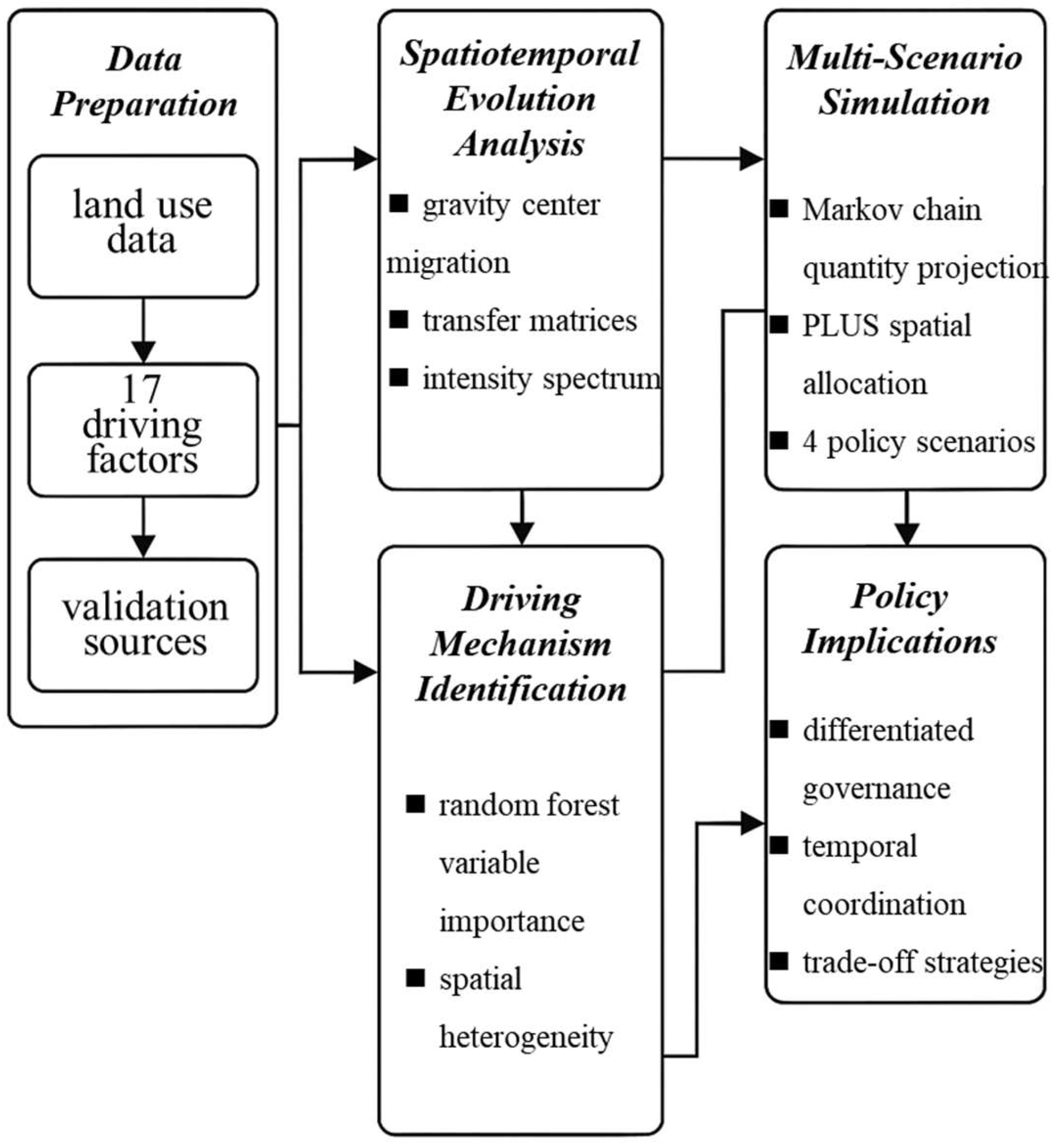

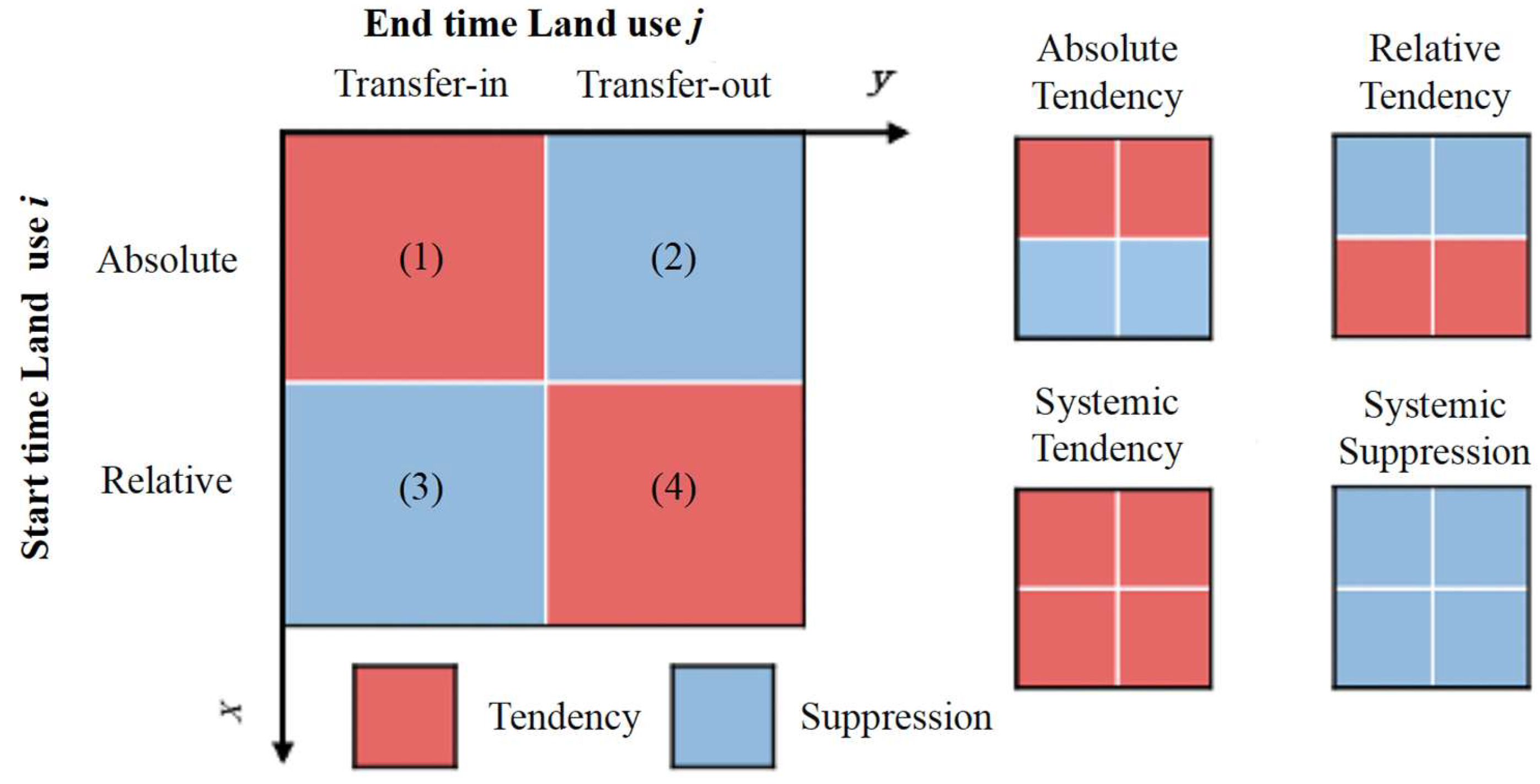



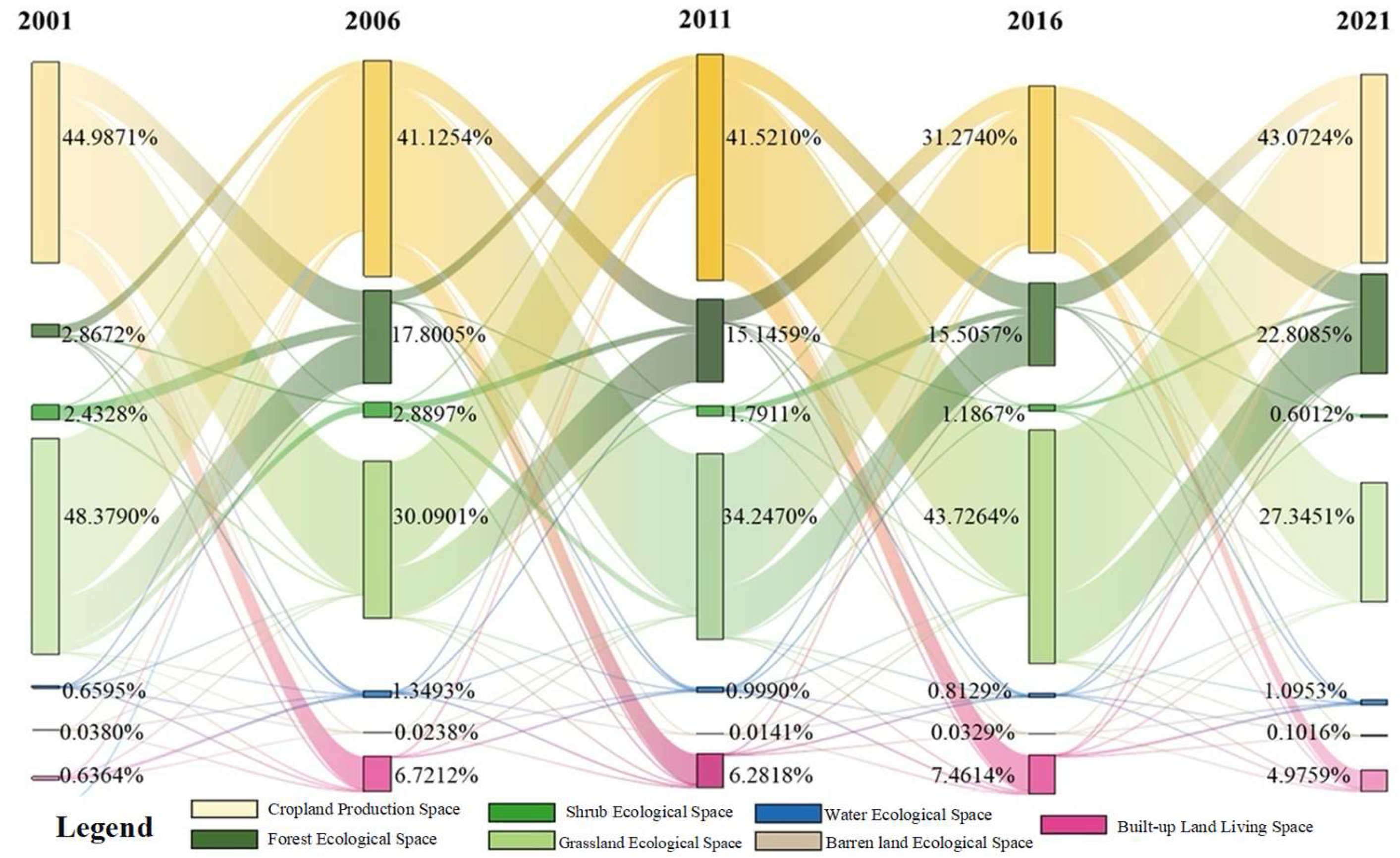
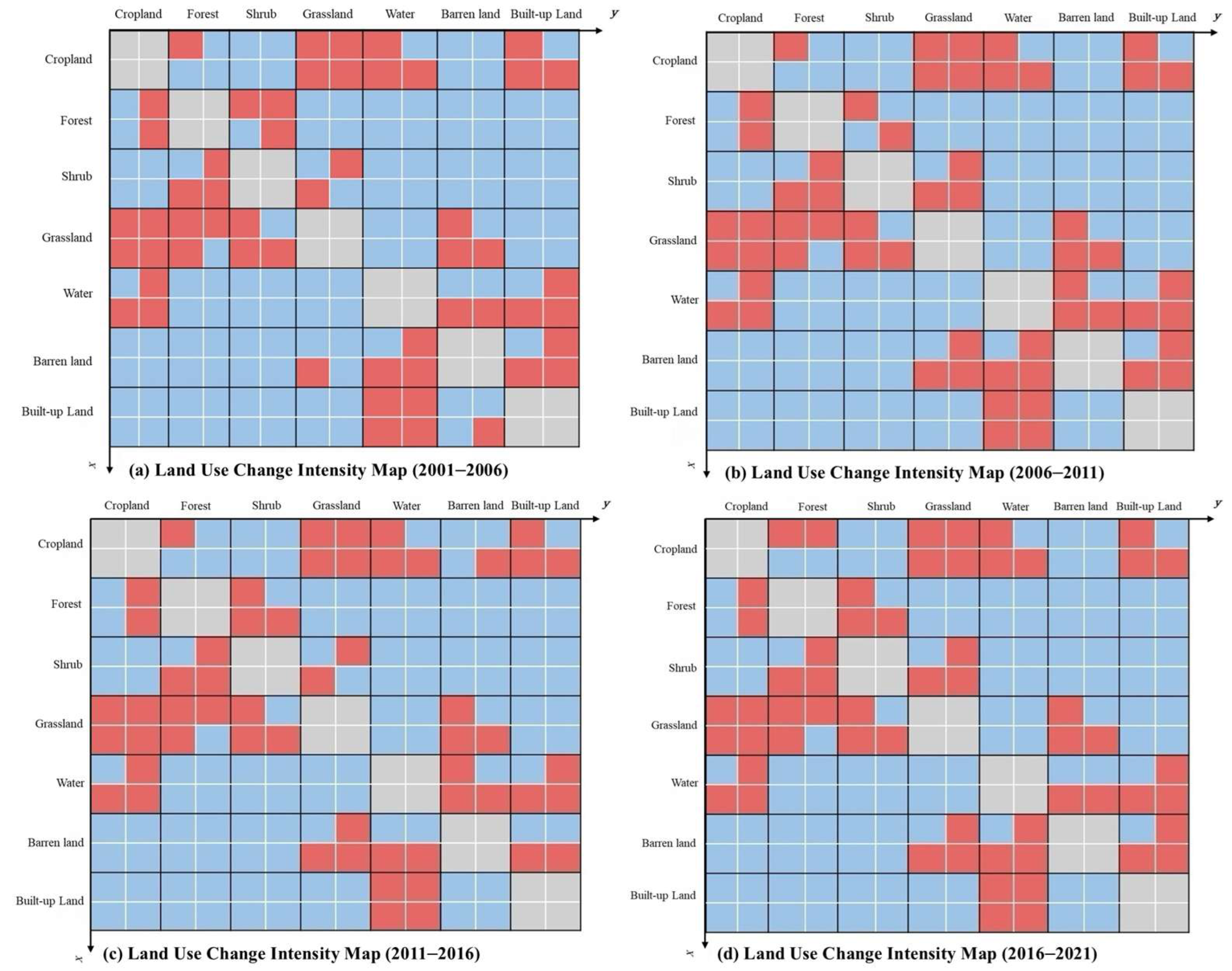

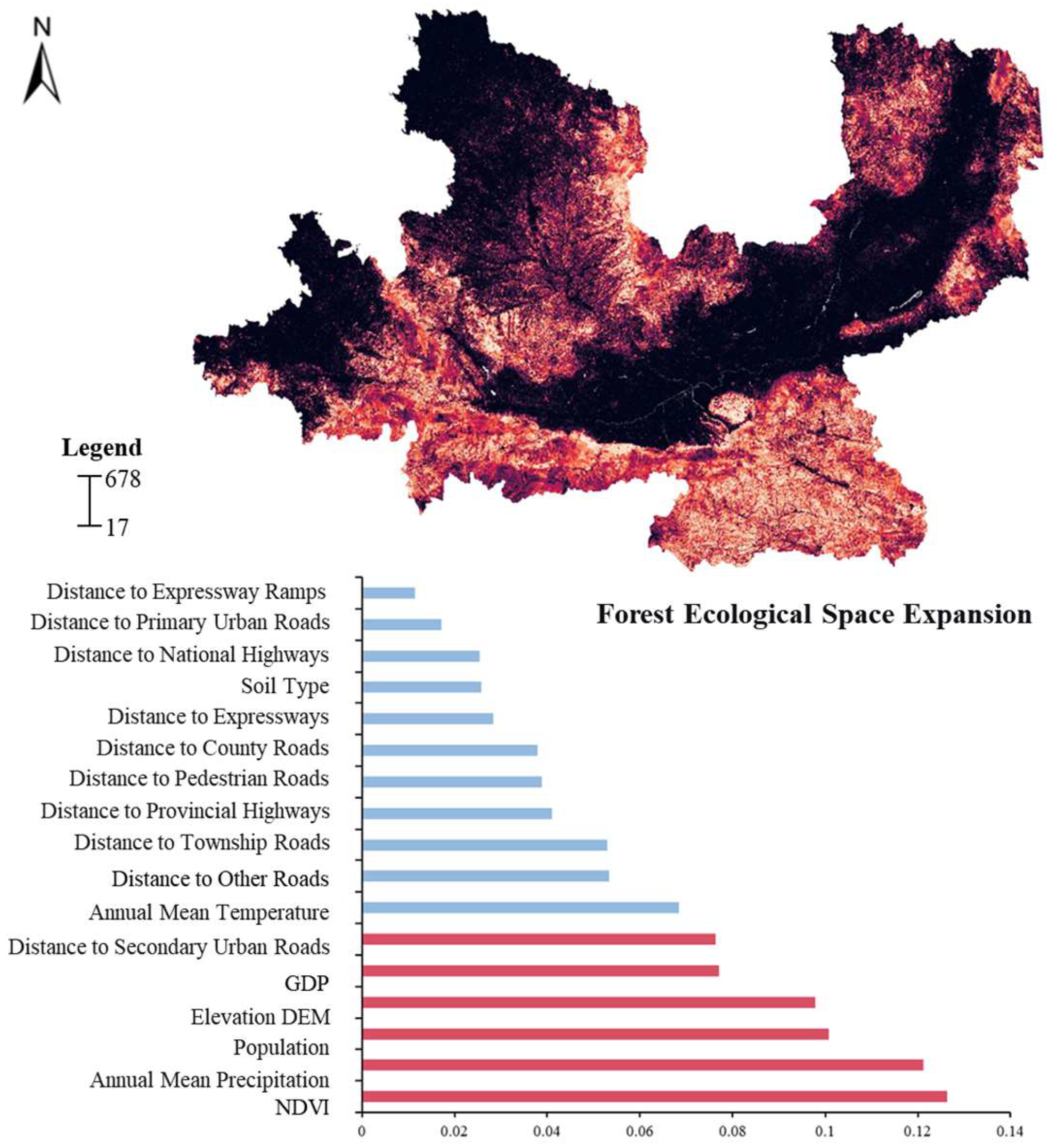
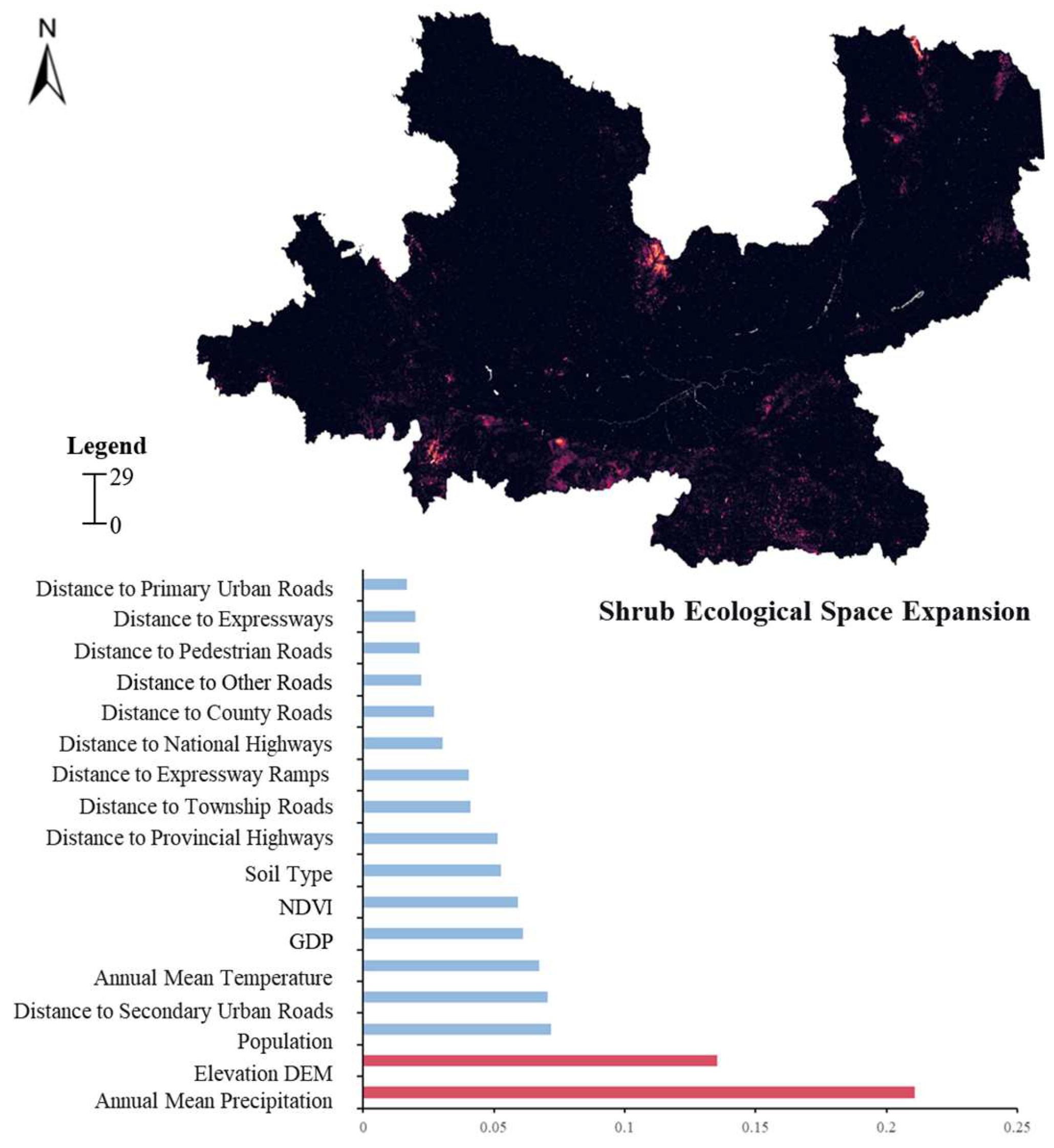


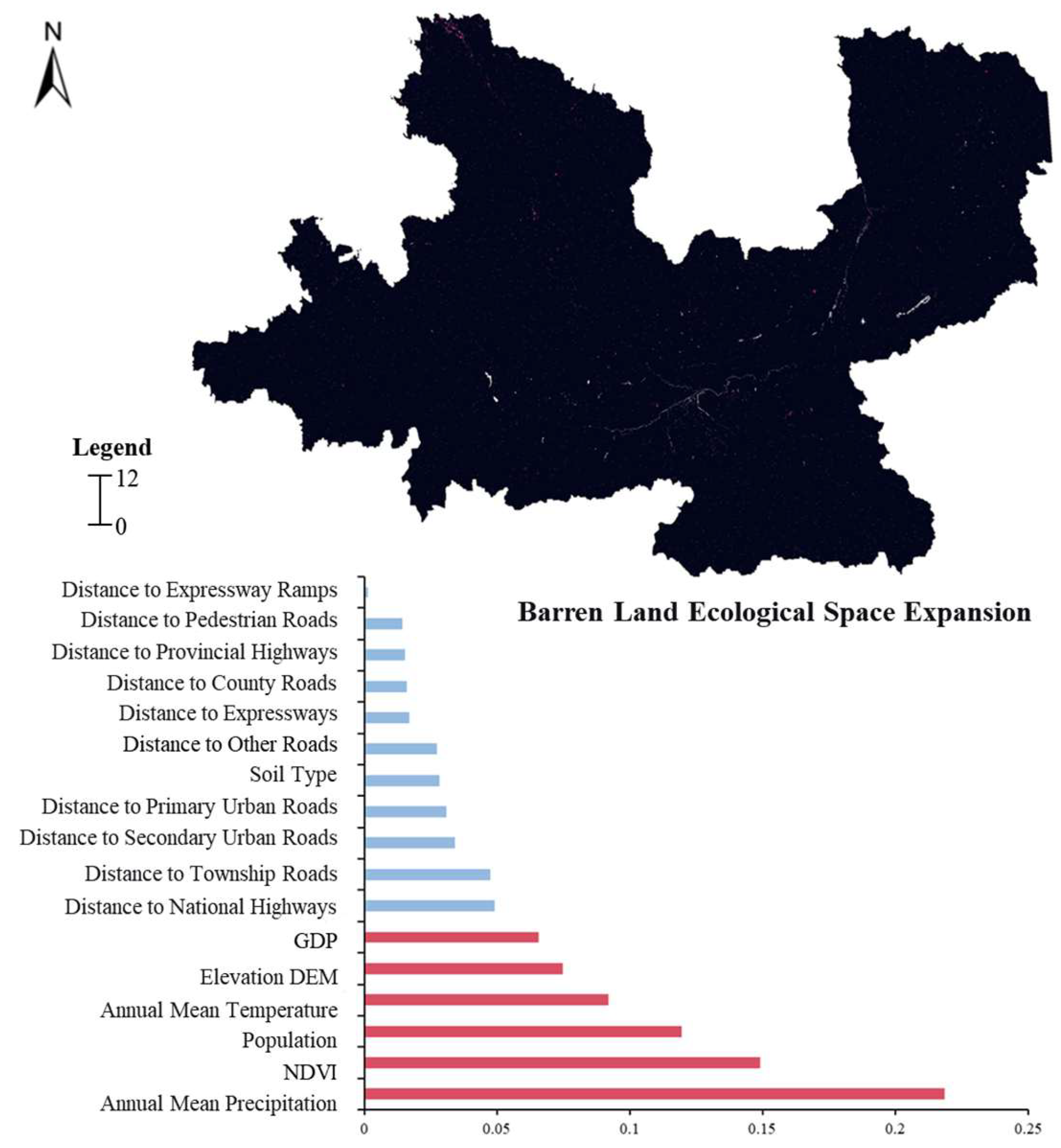

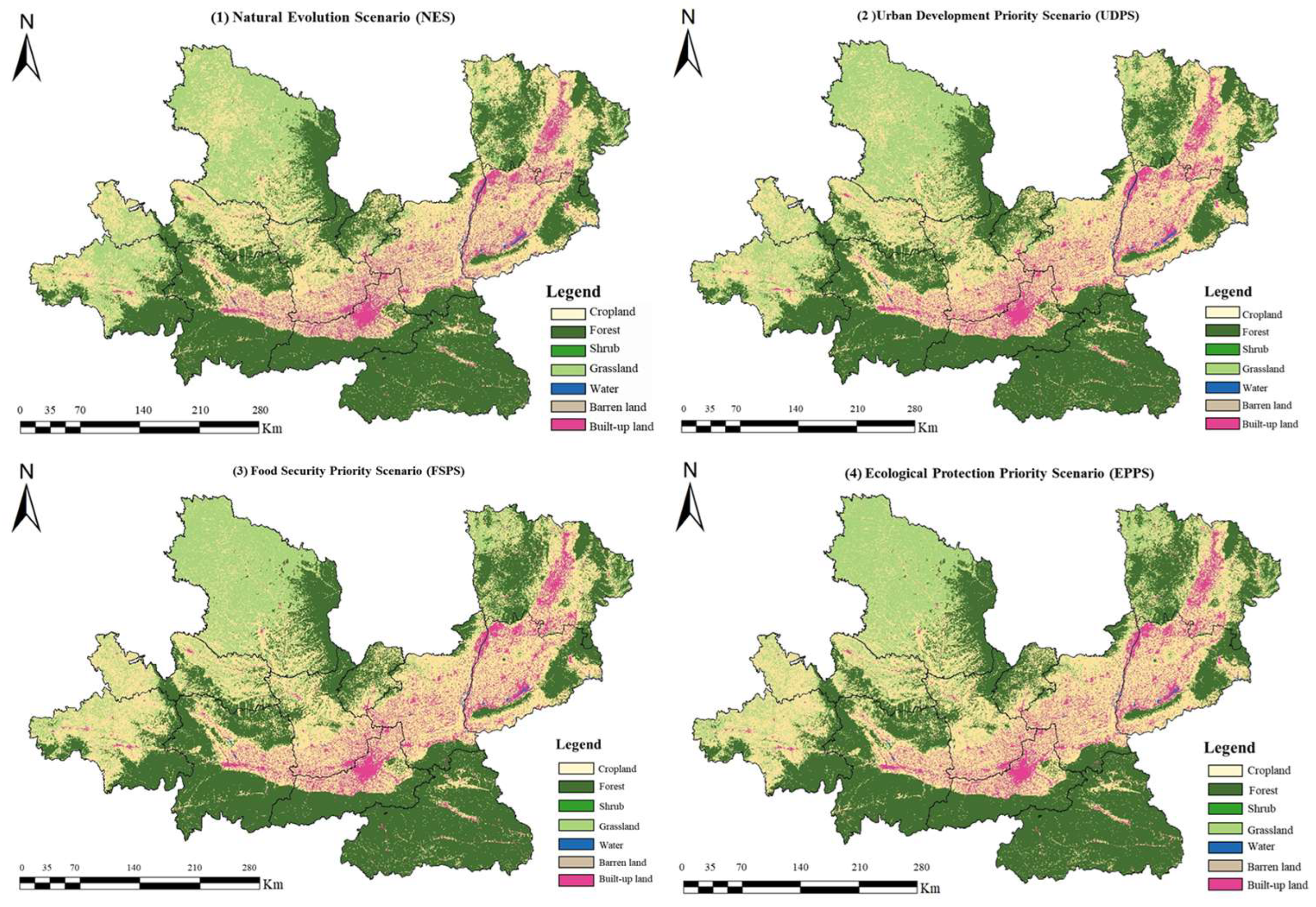
| Data Type | Dataset | Source/Classification | Time Period | Resolution |
|---|---|---|---|---|
| Land Use | Land use classification | China Land Cover Dataset (CLCD) | 2001–2021 | 30 m |
| Environmental Factors | ||||
| Soil type | HWSD v1.2 | World Soil Database | 1995 | 1:1,000,000 |
| Annual temperature | GPR China Temp | Temperature Dataset | 2019 | 1000 m |
| Annual precipitation Elevation (DEM) NDVI | China precipitation GEBCO DEM | Monthly Precipitation | 2019 | 1000 m |
| GEBCO Database | 2020 | 500 m | ||
| China NDVI | Annual Vegetation Index | 2018 | 1000 m | |
| Economic Factors | ||||
| GDP | GDP distribution | China GDP Grid Dataset | 2019 | 1000 m |
| Social Factors | ||||
| Population | World Pop | Population repository | 2020 | 1000 m |
| Distance to highways | Road network | National Geographic Information Center/OSM | 2020 | 1:250,000 |
| Distance to major roads | ||||
| Distance to secondary roads | ||||
| Distance to county roads Distance to rural roads | ||||
| No. | Primary Class | Secondary Class | Code | Production Space Score | Living Space Score | Ecological Space Score | Final Classification |
|---|---|---|---|---|---|---|---|
| 1 | Cropland | Paddy field | 11 | 3 | 0 | 1 | Production |
| 2 | Dry farmland | 12 | 3 | 0 | 1 | Production | |
| 3 | Forest | Forest land | 21 | 0 | 0 | 5 | Ecological |
| 4 | Shrubland | 22 | 0 | 0 | 5 | Ecological | |
| 5 | Sparse woodland | 23 | 0 | 0 | 5 | Ecological | |
| 6 | Other woodland | 24 | 0 | 0 | 5 | Ecological | |
| 7 | Grassland | High coverage | 31 | 0 | 0 | 5 | Ecological |
| 8 | Medium coverage | 32 | 0 | 0 | 5 | Ecological | |
| 9 | Low coverage | 33 | 0 | 0 | 5 | Ecological | |
| 10 | Water | Rivers/canals | 41 | 3 | 0 | 1 | Production |
| 11 | Reservoirs/ponds Beaches | 43 | 1 | 0 | 3 | Ecological | |
| 12 | 46 | 0 | 0 | 5 | Ecological | ||
| 13 | Built-up | Urban land | 51 | 0 | 5 | 0 | Living |
| 14 | Rural settlements | 52 | 0 | 5 | 0 | Living | |
| 15 | Other construction | 53 | 0 | 5 | 0 | Living | |
| 16 | Unused | Sandy land | 61 | 0 | 0 | 5 | Ecological |
| 17 | Wetland | 64 | 0 | 0 | 5 | Ecological | |
| 18 | Bare land | 66 | 0 | 0 | 5 | Ecological | |
| 19 | Other | 67 | 0 | 0 | 5 | Ecological |
| City | Production Space | Ecological Space | Living Space | |||
|---|---|---|---|---|---|---|
| Area (km2) | % of Total | Area (km2) | % of Total | Area (km2) | % of Total | |
| Xian | 3695.48 | 5.81% | 5046.04 | 5.53% | 1357.88 | 19.24% |
| Baoji | 5308.92 | 8.35% | 12,219.26 | 13.38% | 567.72 | 8.04% |
| Xianyang | 6834.32 | 10.75% | 2724.13 | 2.98% | 766.74 | 10.87% |
| Tongchuan | 1649.24 | 2.59% | 2160.87 | 2.37% | 86.10 | 1.22% |
| Weinan | 9063.12 | 14.26% | 2762.75 | 3.03% | 1165.41 | 16.51% |
| Shangluo | 2066.35 | 3.25% | 17,315.67 | 18.96% | 162.94 | 2.31% |
| Tianshui | 6097.81 | 9.59% | 8021.48 | 8.78% | 156.89 | 2.22% |
| Pingliang | 6038.13 | 9.50% | 4974.92 | 5.45% | 105.92 | 1.50% |
| Qingyang | 5881.45 | 9.25% | 21,134.69 | 23.14% | 84.83 | 1.20% |
| Yuncheng | 9275.41 | 14.59% | 3423.99 | 3.75% | 1502.47 | 21.29% |
| Linfen | 7661.35 | 12.05% | 11,531.31 | 12.63% | 1100.01 | 15.59% |
| Land Use Spatial Type | Single Land Use Dynamic Degree | ||||
|---|---|---|---|---|---|
| 2001~2006 | 2006~2011 | 2011~2016 | 2016~2021 | 2001~2021 | |
| Cropland Production Space | −0.22% | −0.71% | −0.51% | 0.16% | −1.26% |
| Forest Ecological Space | 0.79% | 0.66% | 0.54% | 0.67% | 2.78% |
| Shrubland Ecological Space | −2.47% | −7.74% | −7.36% | −6.22% | −15.32% |
| Grassland Ecological Space | −1.05% | 0.07% | −0.29% | −1.55% | −2.72% |
| Water Ecological Space | 5.39% | 1.36% | −0.93% | 2.05% | 8.52% |
| Barren Land Ecological Space | −7.45% | −4.65% | 14.61% | 22.37% | 15.30% |
| Built-up Living Space | 3.93% | 3.26% | 3.30% | 1.45% | 14.79% |
| Comprehensive Land Use Dynamic Degree | 0.19% | 0.14% | 0.15% | 0.18% | 0.17% |
| Metric | Value | Interpretation |
|---|---|---|
| Overall Accuracy | 92.30% | Percentage of correctly classified pixels |
| Kappa coefficient | 0.91 | Agreement beyond chance (>0.81 = almost perfect) |
| Figure of Merit (FoM) | 0.24 | Ratio of correctly predicted changes to total changes |
| Land Use Type | Producer’s Accuracy | User’s Accuracy |
|---|---|---|
| Cropland | 93.2 | 91.7 |
| Forest | 89.8 | 90.3 |
| Grassland | 87.4 | 85.9 |
| Built-up | 91.6 | 93.8 |
| Water | 85.3 | 83.2 |
| Shrubland | 86.7 | 84.5 |
| Barren land | 88.1 | 87.3 |
| Year | Cropland | Forest | Shrub Land | Grassland | Water | Barren Land | Built-Up Land |
|---|---|---|---|---|---|---|---|
| 2001 | 67,837 | 50,291 | 864 | 34,339 | 380 | 81 | 4060 |
| 2006 | 67,088 | 52,284 | 758 | 36,484 | 483 | 51 | 4854 |
| 2011 | 64,717 | 54,000 | 464 | 36,591 | 516 | 34 | 5654 |
| 2016 | 63,063 | 55,446 | 293 | 36,071 | 492 | 68 | 6580 |
| 2021 | 63,574 | 57,289 | 202 | 33,264 | 542 | 143 | 7058 |
| 2026 | 60,196 | 61,432 | 122 | 30,467 | 613 | 151 | 9099 |
| 2031 | 56,204 | 61,369 | 167 | 29,300 | 265 | 33 | 10,961 |
| Transition Type | Natural Evolution | Urban Development Priority | Food Security Priority | Ecological Protection Priority |
|---|---|---|---|---|
| Cropland → Built-up | Baseline | 30% | −60% | −30% |
| Forest → Built-up | Baseline | 20% | Baseline | −50% |
| Grassland → Built-up | Baseline | 20% | Baseline | −50% |
| Built-up Land Constraints | None | None | Strict Basic Farmland Protection | Ecological Red Line Constraints |
| Ecological Restoration Probability | Baseline | Baseline | 10% | 30% |
Disclaimer/Publisher’s Note: The statements, opinions and data contained in all publications are solely those of the individual author(s) and contributor(s) and not of MDPI and/or the editor(s). MDPI and/or the editor(s) disclaim responsibility for any injury to people or property resulting from any ideas, methods, instructions or products referred to in the content. |
© 2025 by the authors. Licensee MDPI, Basel, Switzerland. This article is an open access article distributed under the terms and conditions of the Creative Commons Attribution (CC BY) license (https://creativecommons.org/licenses/by/4.0/).
Share and Cite
Gao, C.; Li, S.; Bao, H.; Zhang, Y. Multi-Dimensional Driving Mechanisms and Scenario Simulation of Production-Living-Ecological Space Evolution in Urban Agglomerations of China: Evidence from the Guanzhong Plain. Land 2025, 14, 2201. https://doi.org/10.3390/land14112201
Gao C, Li S, Bao H, Zhang Y. Multi-Dimensional Driving Mechanisms and Scenario Simulation of Production-Living-Ecological Space Evolution in Urban Agglomerations of China: Evidence from the Guanzhong Plain. Land. 2025; 14(11):2201. https://doi.org/10.3390/land14112201
Chicago/Turabian StyleGao, Chao, Shasha Li, Hanchuan Bao, and Yilin Zhang. 2025. "Multi-Dimensional Driving Mechanisms and Scenario Simulation of Production-Living-Ecological Space Evolution in Urban Agglomerations of China: Evidence from the Guanzhong Plain" Land 14, no. 11: 2201. https://doi.org/10.3390/land14112201
APA StyleGao, C., Li, S., Bao, H., & Zhang, Y. (2025). Multi-Dimensional Driving Mechanisms and Scenario Simulation of Production-Living-Ecological Space Evolution in Urban Agglomerations of China: Evidence from the Guanzhong Plain. Land, 14(11), 2201. https://doi.org/10.3390/land14112201






